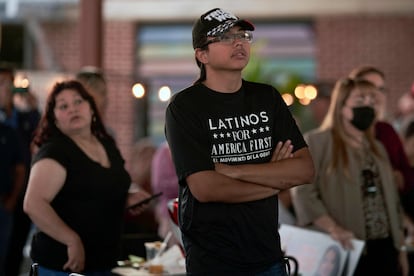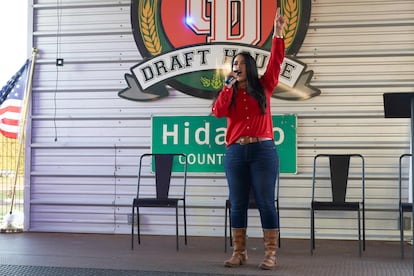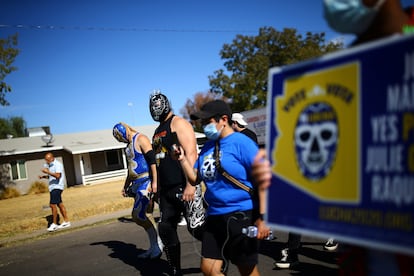How Republicans are winning over Latino voters: ‘Many who came to the US illegally now support getting tough on immigration’
With the midterms looming, Democrat strongholds are at risk as issues such as rising fuel prices and the state of the economy take center stage


The community of Los Indios, in south Texas, is made up of quiet one-story houses that proudly display an American flag. They are built upon vast ranches of very green grass. Among the residences, businesses sell second-hand trucks, and there are also churches. To the back of the community, the wall that divides Mexico and the United States snakes like a gigantic back fence. This area is covered with posters calling for people to vote for Republican congresswoman Mayra Flores. She was the surprise winner of a June special election in the Democratic stronghold, and is hoping to maintain her seat in the House of Representatives at the November 8 midterm elections.
The Latino vote could be decisive in the midterms, as the community seems less willing than before to support the Democrats. In one of the most hotly contested Senate seats (Nevada), and in another Democratic-leaning but undecided seat (Arizona), Latinos make up 20% of voters. And they also make up over 20% in at least a dozen competitive House districts in states such as California, Colorado, Florida and Texas.
Flores will be on the ballot again in November, and she has a good chance of winning in the Rio Grande Valley area of south Texas. Flores is a conservative, with a message closely aligned to that of former US president Donald Trump, who went from securing 28% of the Latino vote in 2016 to 38% four years later, despite his xenophobic messages. “Make America Godly Again” says one of her ads. Another promises: “God, Family and Country.”
Flores’ platform is calling for a hard-line stance on migrants, even though her own family crossed the US border from the Mexican city of Burgos in Tamaulipas. She is also opposed to same-sex marriage, and has harshly criticized high-ranking Democrats such as Nancy Pelosi. Her message has struck a chord in a rural area where Trump made significant gains against Democrat Joe Biden in the 2020 presidential election. The 36-year-old woman raised $1.6 million in donations over the summer, three times more than her opponent. The figure makes it clear that Republicans are finally investing in an area previously considered impenetrable.
Lenny Trejo, 63, says he will vote for Flores. Like the congresswoman, he was also born in Tamaulipas, the Mexican state on the other side of the wall. He has been working for more than 30 years for a transportation company that principally serves northeastern Mexico. “It’s good to be able to vote for someone like us,” he says in Brownsville, a city with a long tradition of progressive voting, but which shows signs of changing to a purple zone – a mix of Republican (red) and Democrat (blue) supporters.
Trejo has never been very interested in politics. He voted for Hillary Clinton in 2016 and decided not to vote in 2020. His biggest concern right now is the economy and rising prices. “It’s been a very tough two years,” he admits. “Gas is through the roof, and it’s the first time in years that I’ve had to help my two daughters pay their bills,” he says. Like many in Texas, he was hit hard by the rising cost of fuel, which reached a 20-year-high. It’s an issue that is weighing heavily on Latino voters ahead of the midterms. According to the independent Pew Research Center, eight out of 10 Latino voters list the economy as a very important issue.

More than 65% also list gun policy as a major concern. This is felt more keenly in Texas after the Uvalde tragedy in May, when an 18-year-old killed 19 children and two teachers at an elementary school in a majority Latino community. The anger felt by the families of the victims has become a force for change. Many support Beto O’Rourke, the politician who aspires to be the first Democrat to govern Texas since Ann Richards in 1991. It seems unlikely: the current governor, Greg Abbott, is leading by almost nine points.
“Historically, 80% of Hispanics were Democrats, but the church has made many go with the Republicans because of their opposition to abortion and gay marriage,” explains Ronald Garza, 58, a Democrat who is fighting to be re-elected as a county commissioner.
Immigration is also a priority issue. This year, the number of undocumented immigrant arrivals has broken all records. For the first time, more than two million arrests were made on the border with Mexico, a phenomenon driven by the rise in migrants from Venezuela, Nicaragua and Cuba. The epicenter of the crisis is Texas, where the governor, in a controversial move, has opted to bus undocumented migrants to northeast Democratic cities, such as Washington DC and New York. The measure may have been criticized by Democrats, but 54% of voters support it, according to a University of Texas/Texas Politics Project Poll.
“I am surprised that many of those who came to this country illegally now support getting tougher on immigration. They tell me that they arrived by legal means, although I know that is not true. Others say it’s ‘me first,’ then the new arrivals,” says Garza.
On the other hand, some analysts believe that eight out of 10 Latinos would not vote for a candidate who does not support immigration reform, which would provide legal pathways to citizenship for millions of undocumented immigrants. Biden promised action on this issue when he entered the White House. But two years on, his remain unfulfilled. Biden’s approval among Latinos is 45%.
Latino vote not monolithic
The Latino vote is not monolithic. The issues that dominate local elections in Chicago are not the same ones that influence voters in California or Florida. There are also distinctions within different Latino groups. Latinos of Mexican and Puerto Rican origin are more likely to support Democrats (58% and 52%, respectively) than Cubans, who mostly support Republicans (55%).

Both major parties need a high turnout to benefit from the Latino vote. Although the midterm elections tend to attract fewer voters, the 2018 midterm election broke records, with a 50.1% turnout rate. “Latinos go out to vote in historic numbers despite the fact that we are the group that receives the least investment in participation,” says Héctor Sánchez Barba, president of the organization Mi Familia Vota (My Family Votes).
Latino voters are also exposed to poor quality information. Spanish-language TV channels and newspapers are only available in a handful of states, meaning many voters turn to social media, which is filled with disinformation, especially during election campaigns. Congressman Joaquín Castro, who represents San Antonio (Texas), has pointed out these dangers. “I’ve been disappointed to see [social media platforms] tolerate lies in Spanish that would never be tolerated in English,” he told the press last week.
Castro pointed out that Trump’s 2020 re-election campaign placed thousands of advertisements on Facebook warning of an “invasion” at the southern US border. “Before that summer was over, a madman took up Trump’s call to action and drove 10 hours to El Paso, where he killed 23 people and injured more than 20 in an attempt to stop what he called the Latino invasion of Texas,” added Castro. Two years later, all eyes are once again on Latino voters.
Tu suscripción se está usando en otro dispositivo
¿Quieres añadir otro usuario a tu suscripción?
Si continúas leyendo en este dispositivo, no se podrá leer en el otro.
FlechaTu suscripción se está usando en otro dispositivo y solo puedes acceder a EL PAÍS desde un dispositivo a la vez.
Si quieres compartir tu cuenta, cambia tu suscripción a la modalidad Premium, así podrás añadir otro usuario. Cada uno accederá con su propia cuenta de email, lo que os permitirá personalizar vuestra experiencia en EL PAÍS.
¿Tienes una suscripción de empresa? Accede aquí para contratar más cuentas.
En el caso de no saber quién está usando tu cuenta, te recomendamos cambiar tu contraseña aquí.
Si decides continuar compartiendo tu cuenta, este mensaje se mostrará en tu dispositivo y en el de la otra persona que está usando tu cuenta de forma indefinida, afectando a tu experiencia de lectura. Puedes consultar aquí los términos y condiciones de la suscripción digital.
More information
Archived In
Últimas noticias
Welcome to the post-religion era: The idea of Christianity as the absolute truth has become obsolete
‘I thought you would like it’: The risky sexual practice popularized by TV shows and TikTok
The digitalization of tourism: ‘They promise experiences and gave us the worst possible one’
Mexican peso defies uncertainty with forecasts of a new period of stability in 2026
Most viewed
- Sinaloa Cartel war is taking its toll on Los Chapitos
- Oona Chaplin: ‘I told James Cameron that I was living in a treehouse and starting a permaculture project with a friend’
- Reinhard Genzel, Nobel laureate in physics: ‘One-minute videos will never give you the truth’
- Why the price of coffee has skyrocketed: from Brazilian plantations to specialty coffee houses
- Silver prices are going crazy: This is what’s fueling the rally










































